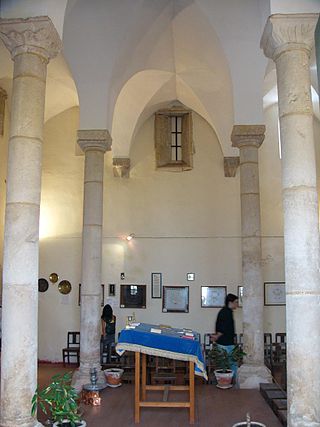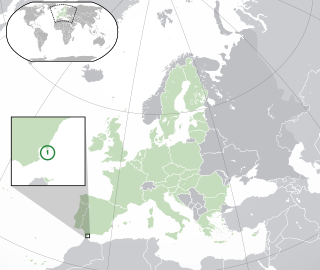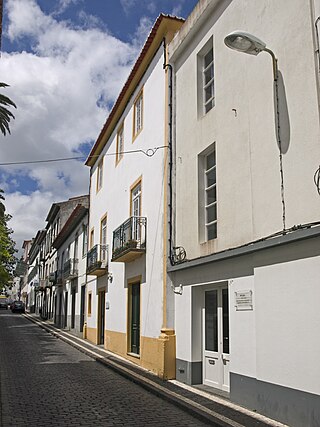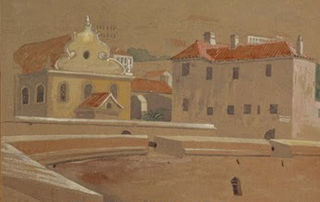
Funchal is the capital, largest city and the municipal seat of Portugal's Autonomous Region of Madeira, bordered by the Atlantic Ocean. The city has a population of 105,795, making it the sixth largest city in Portugal. Because of its high cultural and historical value, Funchal is one of Portugal's main tourist attractions; it is also popular as a destination for New Year's Eve, and it is the leading Portuguese port on cruise liner dockings.

Santa Maria Maior is a civil parish in the eastern part of the municipality of Funchal on the island of Madeira. The population in 2011 was 13,352, in an area of 4.86 km2.

The history of the Jews in Portugal reaches back over two thousand years and is directly related to Sephardi history, a Jewish ethnic division that represents communities that originated in the Iberian Peninsula. In the sixteenth and seventeenth centuries, Portuguese Jews emigrated to a number of European cities outside Portugal, where they established new Portuguese Jewish communities, including in Hamburg, Antwerp, and the Netherlands, which remained connected culturally and economically, in an international commercial network during the seventeenth and eighteenth centuries.

The history of Madeira begins with the discovery of the islands by Portugal in 1419. There is no record of anyone living on the islands at that time. Portugal began populating the island in 1420.

The Synagogue of Tomar is a former Jewish congregation and synagogue, located at 73 Rua Dr. Joaquim Jaquinto, in the historic center of the city of Tomar, in the Santarém District of Portugal. The medieval synagogue was completed in the Gothic style by c. 1460, and was active as a synagogue until 1496, when Jews were expelled from Portugal.
Malaysian Jews are Jews living in Malaysia, whether immigrants or those originally from the country. The state of Penang was once home to a Jewish community, until the latter part of the 1970s, by which time most had emigrated due to growing state-sanctioned antisemitism. Indications of the growing racial and religious hostility in the nation in response to the Israeli–Palestinian conflict has caused many Malaysian Jews to leave or flee the country. The Malaysian Jewish community consists of Jews of Sephardic origin who live discreetly amongst the Kristang people (Malacca-Portuguese), Mizrahi Jews, Malabar Jews, and Ashkenazi Jews.

The Dohány Street Synagogue, also known as the Great Synagogue or Tabakgasse Synagogue, is a Neolog Jewish congregation and synagogue, located on Dohány Street in Erzsébetváros of Budapest, Hungary. It is the largest synagogue in Europe, seating 3,000 people, and is a centre of Neolog Judaism. The congregation worships in the Ashkenazi rite.

The history of the Jews in Malta spans two millennia. A Jewish community is attested on the islands by the 4th-5th century. Jews prospered in Malta under Arab and Norman rule. They were expelled in 1492, and a community could only re-establish itself after 1798 under British rule. In the 19th and 20th century, the Jewish community in Malta welcomed refugees from Italy and Central Europe, escaping Nazi rule. Today, a small community remains well established on the islands.

The Great Synagogue of Gibraltar, also known as Kahal Kadosh Sha'ar HaShamayim, is located in the British overseas territory of Gibraltar, and was the first synagogue on the Iberian Peninsula to operate since the expulsions from Spain and Portugal in 1492 and 1497 respectively.

The history of the Jews in Gibraltar dates back more than 650 years. There have been periods of persecution, but for the most part the Jews of Gibraltar have prospered and been one of the largest religious minorities in the city, where they have made contributions to the culture, defence, and Government of Gibraltar.

During World War II, the British government evacuated the majority of the civilian population of Gibraltar in 1940 in order to reinforce the territory with more military personnel, though civilians with essential jobs were permitted to stay. The civilian evacuees were sent to numerous locations, including London, Madeira and Jamaica; some spent up to a decade away from Gibraltar, but the majority returned in 1943 after the Allied invasion of Sicily. The evacuation reinforced the British national identity of the Gibraltarians via their participation in the Allied war effort.

The Kadoorie Mekor Haim Synagogue, also the Porto Synagogue, is an Orthodox Jewish congregation and synagogue, located at 340 Guerra Junqueiro Street, in the civil parish of Lordelo do Ouro e Massarelos, the municipality of Porto, in the northern region of Portugal.

The Sahar Hassamain Synagogue is a former Jewish congregation and synagogue, located at 16 Rua de Brum, Ponta Delgada, on São Miguel Island, in the Azores region of Portugal. The former synagogue was completed in 1836 and is the oldest synagogue in Portugal, built after the expulsion of Jews from the Iberian Peninsula.

The four active synagogues of Gibraltar are colloquially known as the Great Synagogue, the Little Synagogue, the Flemish Synagogue, and the Abudarham Synagogue. The first synagogue established after the 1717 expulsion of Jews from Gibraltar, the Great Synagogue, was built on what is now known as Engineer Lane, and remains Gibraltar's principal synagogue. The Little Synagogue, founded in 1759 in Irish Town, was the result of the desire of Moroccan Jews for a less formal service. The lavish Flemish Synagogue was built at the turn of the nineteenth century on Line Wall Road, due to the request of some congregants for a return to more formal, Dutch customs. The last synagogue to be established in what is now the British overseas territory of Gibraltar, the Abudarham Synagogue, was founded in 1820 on Parliament Lane by recent Moroccan immigrants.
Jews' Gate Cemetery is a Jewish cemetery located on Windmill Hill within a nature reserve in the British Overseas Territory of Gibraltar. Also known as the Windmill Hill Cemetery, it is the site of the earliest known Jewish burials in Gibraltar. The cemetery opened by 1746 and closed in 1848. It is the burial site of a number of Gibraltar's Chief Rabbis. The graveyard is protected by the law of Gibraltar.
Solomon Abudarham was Chief Rabbi of the British Overseas Territory of Gibraltar until his death from yellow fever in December 1804. Also known as Shelomo Abudarham II, the rabbi established a school of religious study on Parliament Lane and laid the inaugural stone for the Flemish Synagogue on Line Wall Road. In 1820, his academy was converted into the Abudarham Synagogue, named after the rabbi.

Miguel Filipe Machado de Albuquerque is a Portuguese politician of the Social Democratic Party (PSD) and the current President of the Regional Government of Madeira. He took office as leader of the PSD of Madeira on 10 January 2015. He was a former mayor of Funchal, Madeira. Albuquerque likes gardening and used to grow many types of roses in his Rose Garden and the Quinta do Arco.

The Jewish Cemetery of Funchal is a Jewish cemetery located in Rua do Lazareto, Funchal, Madeira. Sephardi Jews as well as Ashkenazi Jews are buried here.

The history of the Jews in Madeira spans the entire length of the history of Madeira itself. The history of Madeira begins with the discovery of the islands by Portugal in 1419. Madeira is presently officially the Autonomous Region of Madeira, and is one of the two autonomous regions of Portugal. It is an archipelago situated in the north Atlantic Ocean, southwest of Portugal. According to the 2021 census, it had a total population of 250,744. The capital of Madeira is Funchal, which is located on the main island's south coast.
The following is a timeline of the history of the city of Funchal, Madeira, Portugal.

















